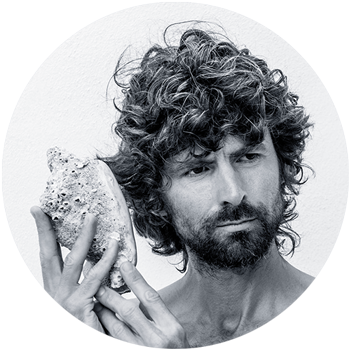
Inquiry: Five Acts
The first imperative verb in the Bhagavad Gītā is pasya meaning look, be alert, be attentive, pay attention. So we might say that the basic practice in yoga is attentiveness. Yoga practice techniques are designed to help us notice more, to train us to centre, to come into congruent, cohesive harmony, to gather and unify all our miraculous powers of body, sense, mind, emotion and intellect so we may experience and ultimately reside in the wholeness that is so much greater than the sum of our parts.
Meditation practices help train us to stand: to live, move and exist, in the balanced space of the centre. We can train ourselves in this ‘way’ of meditation, by taking recourse to what is referred to in the Yoga Sūtra as an ālambana, an object of support around which we can gather and focus the powers of our awareness. When we notice that our awareness has come away from this centre, we do not get downcast, rather we quietly celebrate the noticing, which empowers us to once again, patiently, compassionately, invite the powers of our awareness to gather and centre around that focal point of the chosen ālambana, or support for meditation.
Āsana practices can help train us to invite our action and sense powers more fully into the present moment, to stay spacious and easy in all sorts of orientations. By cultivating space, balance and easefulness in all manner of shapes and expressions, we can start to train ourselves, at the level of our cells, to stay steady and easy come what may.
Another great support into the attentive looking of yoga practice is inquiry
There are many frames and references from the yoga tradition that I find very practical and helpful as lenses for inquiry. One such frame is the Five Great Acts of the Supreme, or the Five Great Acts of Consciousness: acts that we are complicit in and can participate in more, or less, consciously. I find that inquiring regularly through the help of such lenses can really help me see a little more of myself, understand who I am a little more fully, and help reveal where I am perhaps getting in my own way.
The Five Acts:
Sṛṣṭi – generally translated as ‘creation’, but the Sanskṛt has the sense of expanding, spreading, sowing.
Sthiti – often rendered as ‘maintenance’, but literally ‘steady’, so also helpfully conveyed by sustaining, holding, persevering
Samāhāra – sometimes represented as ‘destruction’, but really ‘drawing back in’, pulling back, dissolving.
These three can also be considered as three parts of one cycle. The cycle Clarissa Pinkola Estes calls the life-death-life cycle. There can be no expansion without the previous drawing back. The inhale requires the space afforded by the exhale.
This is represented beautifully by the deciduous tree, one of the host of brilliant guru-s of Nature.
In the autumn time, the tree does not cling to its leaves. Instead, after a glorious fire-show of colour to celebrate all the growth and expansions of the previous seasons of burgeoning growth, the coming into bud and then maturity of certain fruits and gifts, the tree graciously and generously gives back to the very earth and root system that have supported and allowed all that previous growth. And then, as the cycle moves into waning, as the rhythm slows, and the temperature cools, leaves become mulch, and compost, life is recycled. In the quiet of winter, beneath the frozen ground, in the warmer bosom of the earth, in the deeper recesses of the root system, great assimilations are taking place, new possibilities are incubating, and the potential for new calibrations and greater growth is quietly being prepared. The cycles roll on, the sustenance and continuance actually rest on the expansion and contraction. Pulsating – cycling: two ways of conceiving and appreciating the reality of life.
…
So, ‘creation-maintenance-destruction’ then can be seen as three aspects of one continuing principle of Life, three aspects that we might equally refer to as expanding or sowing, staying or holding, and gathering in or drawing back.
These three aspects are sometimes referred to as Brahmā, Viṣṇu and Śiva. However, these three are also referred to as three of the Five Acts of the Supreme, which could be referred to as Viṣṇu, Mother Divine, or as I am referencing here, Śiva!
The Fourth Act is known as tirodhana bhāva which is the state of concealing, forgetting, veiling, blindness, ignorance, forgetfulness. It is that state of ignoring, forgetting or being veiled to our essence: to our ultimate nature. More immediately it is the state of being veiled to the unfiltered light, or unhindered voice, of our conscience.
The Fifth Act of Consciousness is anugraha, grace, or revelation: the revealing of our true nature, that leads to realisation.
The Five Acts of the Supreme as practical lenses for check-in and inquiry
Here are some questions or frames we might use for inquiry:
1, Sṛṣṭi – creation, expansion
What do I really want in my life? What do I want to create more of in my life? What do I really want to embody, share, give and receive in my life? How are my actions facilitating/cultivating/inviting/ moving towards this? If my actions are not helping move towards this, why am I doing them/why am I acting as I am?
What can I do, what are practical steps I can take to help me move more in the direction of what I would like to create more of in my life?
2, Sthiti – sustenance, maintenance
What do I want to maintain in my life?
Honestly, holistically, what does this require or demand?
3, Samāhāra – dissolution, drawing back in, destruction/transformation
What do I want to pull back from, desist from, dissolve? How are my actions helping me move towards this? If my actions are not helping me move towards this, how can I modify them? Can I do them differently?
What are some practical steps I can take to move in this direction?
4, Tirodhana Bhāva – concealing, veiling
How am I being wilfully complicit in my own continuing ignorance? How am I participating in perpetuating my own identification with limiting false beliefs?
How am I being wilfully naïve?
Where do I need to grow up?
5, Anugraha – grace, revelation, re-membering, re-cognising
Are there ways in which I am inviting grace into my life? Could I do more to invite grace and remembering into my life? What does this mean practically for me?
What are some practical, realisable actions I can take to invite more grace and remembering into my life?

James Boag | Whole Life Yoga
The yoga of the whole human being. Practical philosophy, storytelling, movement, inquiry, looking in ways that reach beyond our habitual ways of looking.
Listen to James’ unique whole life yoga perspectives on the WHOLE LIFE YOGA podcast.











